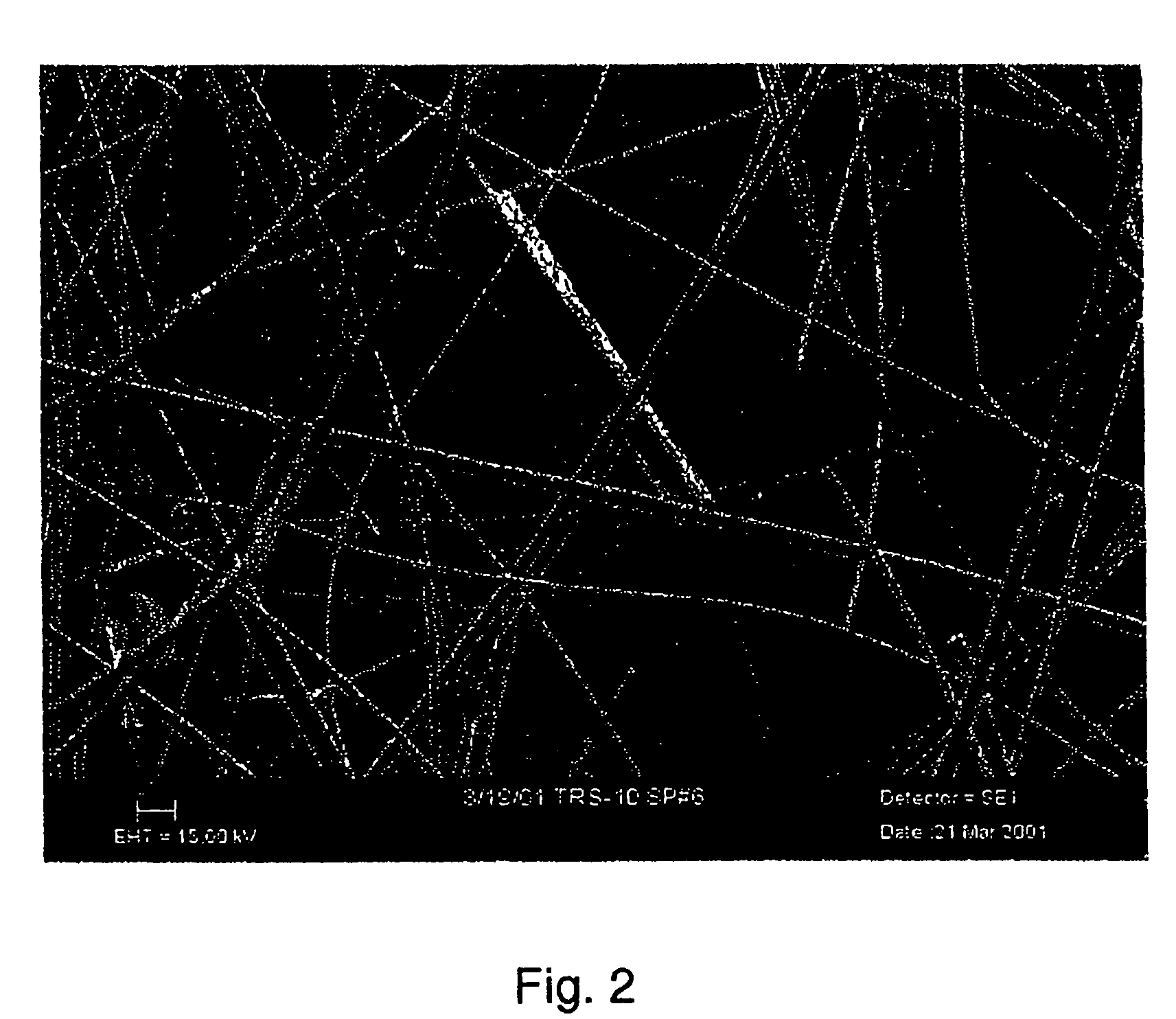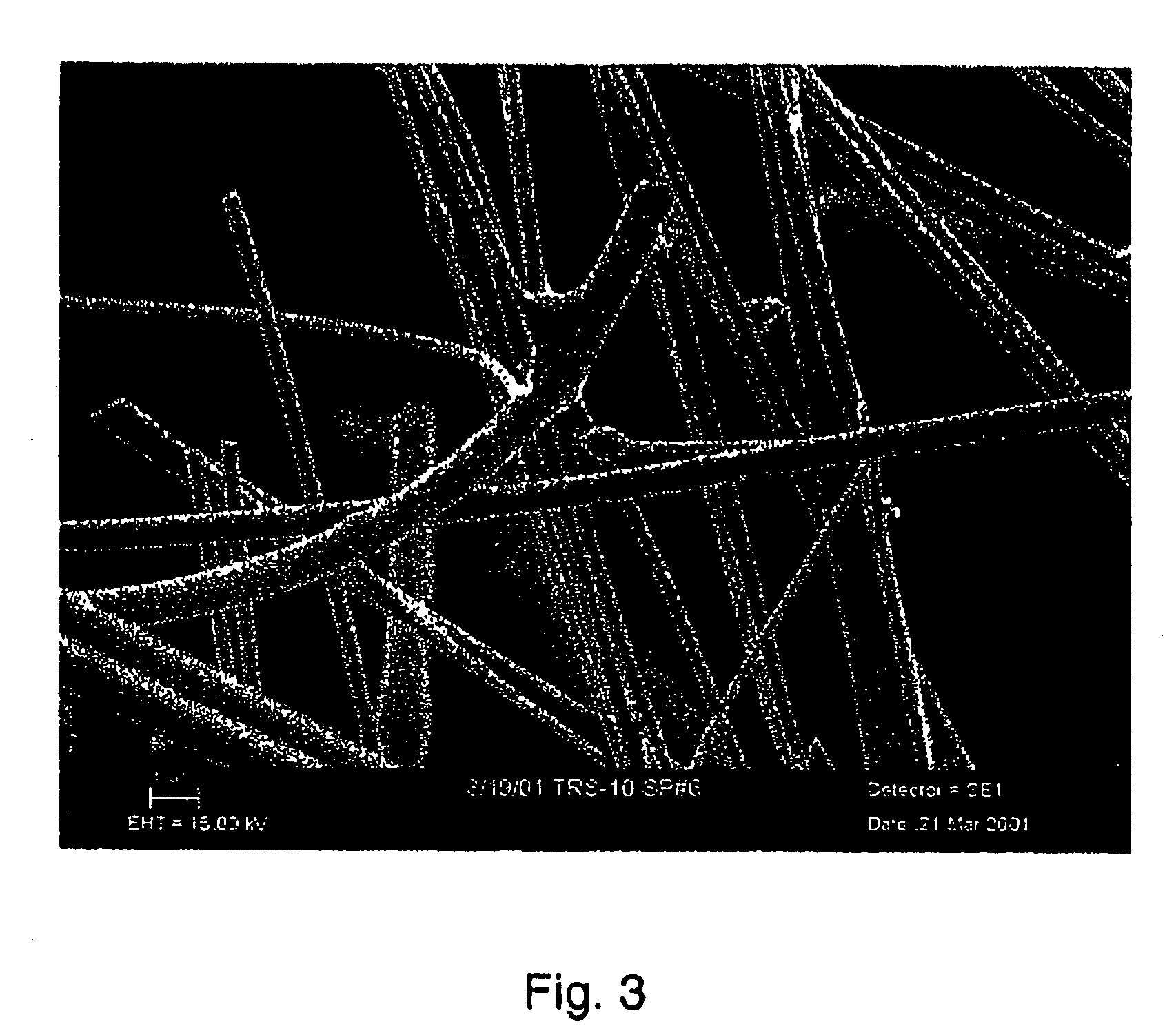Surfactant-containing insulation binder
a fiberglass and polymer technology, applied in the field of fiberglass insulation, can solve the problems of poor interfacing/wetting between glass and polyacrylic, high surface tension, undesirable droplet size and binder distribution, etc., and achieve the effects of improving fiber protection, reducing surface tension of polycarboxy polymer binder composition, and improving wetting and distribution of binder into fiberglass matrix
- Summary
- Abstract
- Description
- Claims
- Application Information
AI Technical Summary
Benefits of technology
Problems solved by technology
Method used
Image
Examples
example 1
[0029] A polyacrylic acid based binder having a solids content of 2.8 weight-% was prepared by diluting QRXP 1564 with water, followed by the addition of amino silane and oil emulsion. To make binder products of the present invention, small amounts (0.1 weight-% and 0.2 weight-%) of Surfynol 465 were blended into the binder composition.
[0030] Surface tensions of the polyacrylic acid based binder compositions of this invention and of two reference binder compositions were measured using a Surface Tensionmeter 6000, produced by the SensaDyne Instrument Division of the Chem-Dyne Research Group. The instrument was calibrated with deionized water. The data were taken every 5 seconds. After the testing started and the system stabilized, the average value over a one-minute testing period was obtained for each sample. The results are reported in Table 1.
TABLE 1SurfaceTensionBinder Description(dyne / cm)QRXP 1564 2.8% solid70.94QRXP 1564 2.8% + 0.1% S-46562.87QRXP 1564 2.8% ...
example 2
Binding Strength
[0032] A polyacrylic acid binder premix was prepared composed on 74.25 parts by weight (pbw) of Acumer 9932 (a 46% solids polyacrylic acid from Rohm & Haas), 10.40 pbw glycerol, 0.45 pbw corrosion inhibitor, and 14.90 pbw water, to provide a 45% solids premix. The premix was added along with silane and oil emulsion to water to provide a 3.5% solids polyacrylic acid glycerol binder (PAG+).
[0033] Surfynol 465 surfactant was added to this polyacrylic acid glycerol binder at various % levels based on the binder solids. These binder compositions were sprayed onto fiberglass as in a typical fiberglass insulation binder application to obtain a Loss On Ignition (LOI) of 1.9%. The binder fiberglass was formed into insulation blankets, conveyed to an oven, and cured therein at temperatures ranging from 350 to 590° F. The bond strength, a measure of mechanical strength, of the cured bindered insulation products was measured and is reported in Table 2.
TABLE 2BondStrengthBind...
example 3
SEM Examination
[0035] Scanning Electron Microscope imaging reveals structural details relating to the manner in which binder is distributed in a fiberglass matrix. SEM provides insight into such details as droplet size, wetting performance, and fiber-fiber junctions. FIG. 1 shows fiberglass insulation produced with no surfactant added to the polyacrylic acid binder. This sample shows poor binder dispersion and poor atomization. This “prior art” binder is poorly distributed throughout the pack and even forms some binder “nests”. FIGS. 2 and 3 show fiberglass insulation produced with surfactant added in accordance with this invention. In these products, the binder was much more uniformly distributed throughout the matrix, the binder showed much better wetting on the glass fiber surface, and more and better fiber-fiber junctions were observed. Thus the present invention significantly improves binder atomization, binder distribution, and binder wetting.
[0036] Fiberglass insulation pro...
PUM
| Property | Measurement | Unit |
|---|---|---|
| surface tension | aaaaa | aaaaa |
| temperature | aaaaa | aaaaa |
| surface tension | aaaaa | aaaaa |
Abstract
Description
Claims
Application Information
 Login to View More
Login to View More - R&D
- Intellectual Property
- Life Sciences
- Materials
- Tech Scout
- Unparalleled Data Quality
- Higher Quality Content
- 60% Fewer Hallucinations
Browse by: Latest US Patents, China's latest patents, Technical Efficacy Thesaurus, Application Domain, Technology Topic, Popular Technical Reports.
© 2025 PatSnap. All rights reserved.Legal|Privacy policy|Modern Slavery Act Transparency Statement|Sitemap|About US| Contact US: help@patsnap.com



